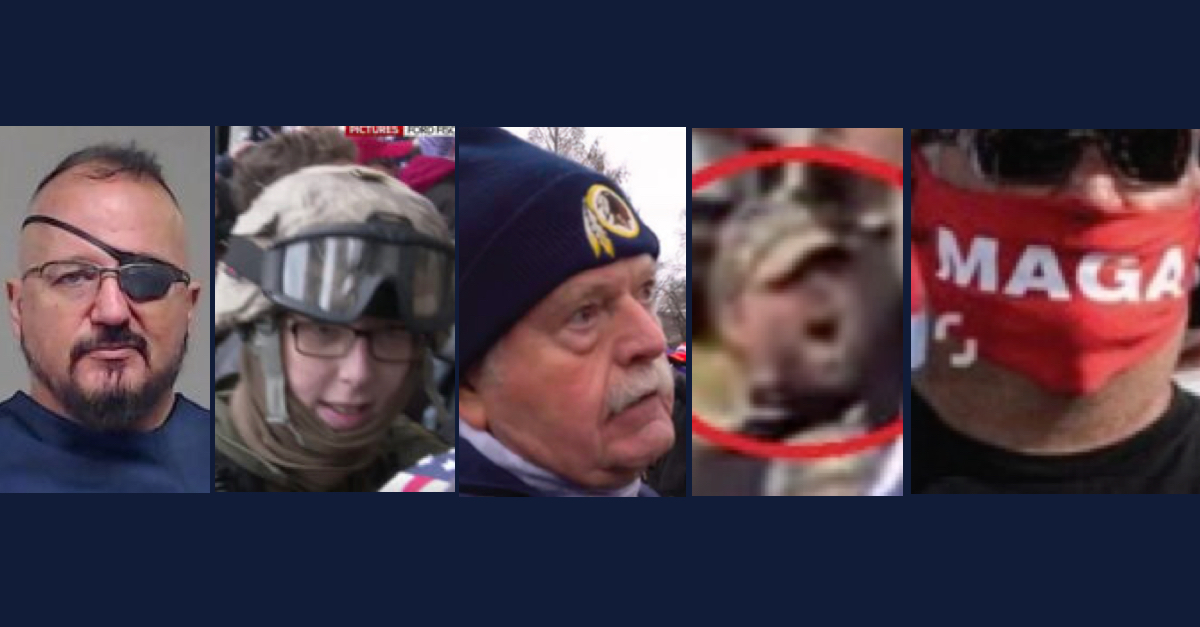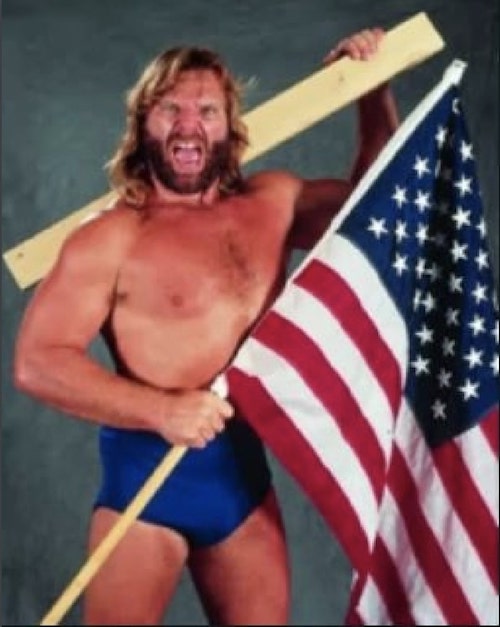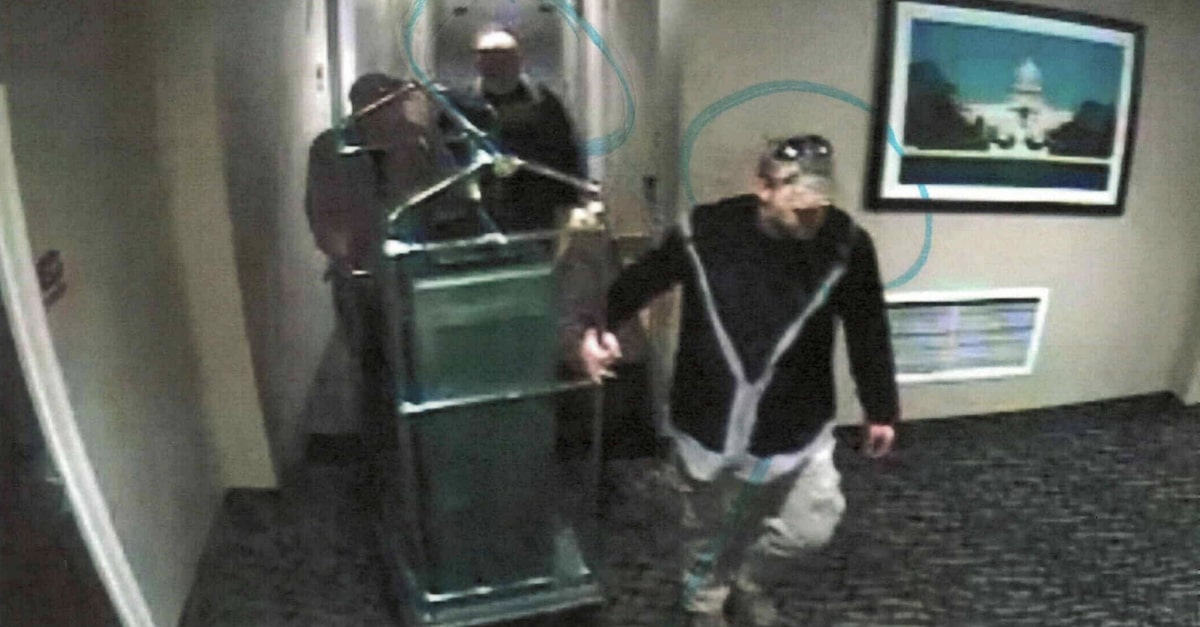
Left-Right: Stewart Rhodes, Jessica Watkins, Thomas Caldwell, Kenneth Harrelson, Kelly Meggs. (Image of Rhodes via the Collin County, Texas Jail; other images via FBI court filings.)
Deploying cell-phone tower location data, federal prosecutors on Thursday established that high-ranking members of the Oath Keepers converged at the Virginia hotel identified as the base of their so-called “Quick Reaction Force.”
The revelation occurred on the day that proceedings of the Jan. 6 Committee indicated that the Secret Service was aware of the so-called QRF, a band of Oath Keepers prosecutors say stood on standby if needed to ferry firearms into Washington, D.C.
In a day of cross-examination and testimony that swung from the absurd to the mundane, a lawyer for the Florida head of the Oath Keepers militia group sought to mitigate potentially damaging messages and social media posts from his client in the days and weeks leading up to Jan. 6, while prosecutors presented highly technical evidence of the defendants’ locations around that same time.
“You’re Aware That the WWE Is Fake?”
Following a morning of testimony from FBI Special Agent Kelsey Harris that included several texts from defendant Kelly Meggs appearing to show Meggs recruiting potential members and preparing them for a potentially violent clash on Jan. 6, Meggs’ lawyer Stanley Woodward sought to put a different spin on what the jury had seen.
Woodward brought up an “unconventional warfare” training Meggs allegedly attended in November of 2020, linking it back to Harris’ testimony on Wednesday about efforts by Meggs and others to use VPN, encryption technology, and other tactics — such as changing their user names in GoToMeeting calls and Signal chats — to mask their identities. Harris testified that Meggs and others started to implement such changes in November, and Woodward’s questions suggested that it was a tactic Meggs learned from this training.
Woodward also recalled testimony from Harris about a Jan. 1, 2021 message from Meggs to the DC OP Jan. 6 21 Signal chat: “I’ve [sic] bringing an OK flag on a nice thick piece of wood.”
That statement was followed by an emoji of a tree stump.
“That will be enough for me,” Meggs wrote in the same thread. “Hacksaw Jim Dugan [sic] style.”
Harris had testified that Jim Duggan was a one-time professional wrestler with World Wrestling Entertainment (WWE) who whose weapons of choice were an American flag and a plank of wood.

Photo of WWE wrestler Jim Duggan entered into evidence during the Oath Keepers seditious conspiracy trial. (Photo via DOJ)
“You’re aware that the WWE is fake?” Woodward asked Harris on Thursday.
“I think we’re all aware that no one is actually harmed [during WWE matches],” the agent replied.
“He’s not actually hurting people with this 2×4?” Woodward asked.
“No, but he’s acting as if he’s hurting people,” Harris responded.
“He’s pretending?” Woodward asked, driving the point home.
“Yes,” Harris responded.
Woodward then asked Harris to identify Meggs in a picture taken in the area near the Capitol on Jan. 6, and asks the agent if Meggs was carrying a 2×4 at the time.
Harris testified that he was not.
Woodward also recalled testimony from Harris earlier in the day about a Dec. 23, 2020 Facebook comment from Meggs in response to a public Facebook post: a meme of a guillotine fashioned as a Home Depot advertisement, and a suggestion that one could spend their $600 Covid-related stimulus at Home Depot to buy the components to build the decapitation device.
Woodward asked Harris if the meme is actually describing how to build a guillotine. Harris responded that it does show all the device’s components.
“The Best Litigators Are Artists. But the Best Artists Know the Science Perfectly.”
Testimony from another government witness, FBI Special Agent Jennifer Banks, who specializes in cell phone location tracking. After establishing Banks’ expertise, which she obtained through special training and maintains through annual classes, prosecutor Louis Manzo had Banks walk the jury through a series of maps that tracked the location of defendants’ cell phones.
One map showed Rhodes’ phone as it appeared to move eastward from Texas to Washington in the days ahead of Jan. 6. Another map showed the phone of co-defendant Ed Vallejo, who is set to be tried in November, along a similar route.
Other maps appeared to show several of the Oath Keepers defendants and associates in a key location: the Comfort Inn in Arlington, Virginia, where the defendants are alleged to have staged a “Quick Reaction Force” of weapons ready to be brought to the Capitol.
The highly technical and fairly dry evidence appeared to land a key blow for prosecutors: placing the so-called QRF in the area of the hotel where the government says Oath Keepers members traveled, armed, to potentially ferry firearms across the Potomac at Trump’s request. Trump never called them, and the plan never came to pass. But the government, in entering the technical evidence, established a record for an allegation that remains thus far undisputed.

Oath Keepers members Thomas Caldwell and Kenneth Harrelson move a cart of what prosecutors allege to be weapons inside a Comfort Inn in Virginia, for their so-called “Quick Reaction Force.” Prosecutors allege that they planned to ferry those firearms across the Potomac if then-President Trump called them. (Photo via DOJ)
Defense attorneys have not, so far, challenged whether their clients were in Washington on Jan. 6, but rather why they were there — and whether what they did was illegal.
The presentation of such information — while undeniably necessary — presents a challenge to prosecutors looking to keep a jury’s interest.
Former federal prosecutor Michael Harwin called the dilemma an “age old question” that prosecutors face.
“Nearly every trial has aspects of it that are tedious and boring,” said Harwin, who is not connected to the case. “But you need to get that evidence in to prove the elements of the offense.”
Harwin said that prosecutors are more likely to be effective if they remind the jury of how the evidence is linked to their theory of the case.
“The best litigators do a great job eliciting testimony in a way that ties it directly into the fabric of the broader story that they’re telling,” Harwin told Law&Crime. “How do they do it when the details become tedious? Sometimes with personality, humor, anything that can break up the tedium and monotony. Sometimes it’s ok to let your scientific and technical evidence blend into the background as if it’s beyond dispute.”
“Trial practice is as much of an art as it is a science,” Harwin added. “The best litigators are artists. But the best artists know the science perfectly.”
[Image of Rhodes via Collin County (Tex.) Jail. Images of Watkins, Harrelson, Caldwell, and Meggs via FBI court filings.]
Have a tip we should know? [email protected]